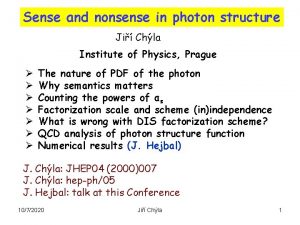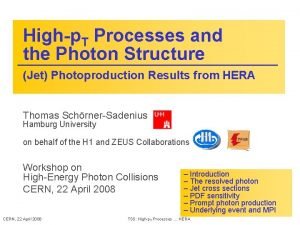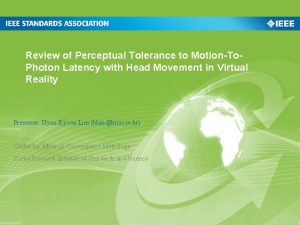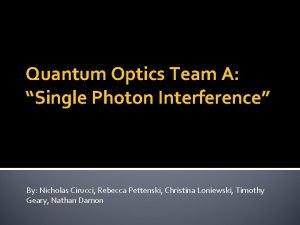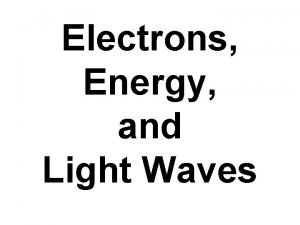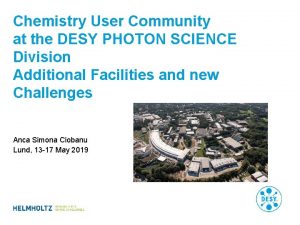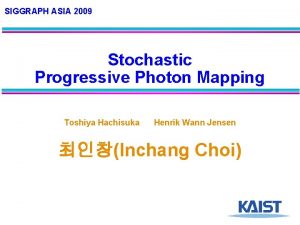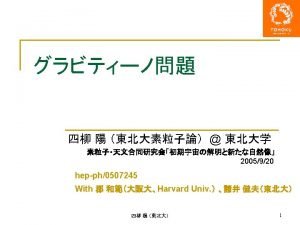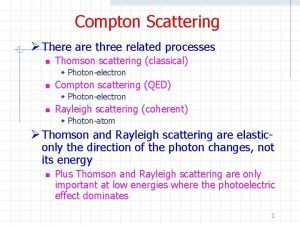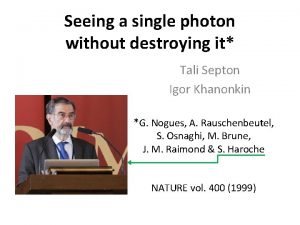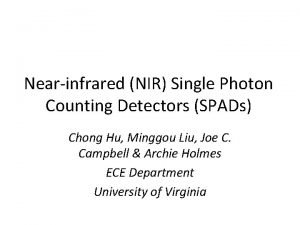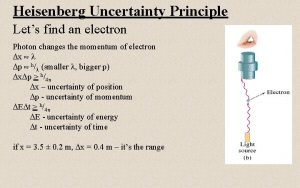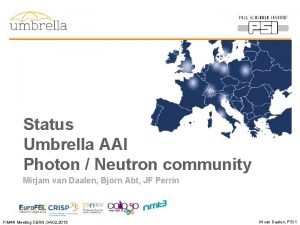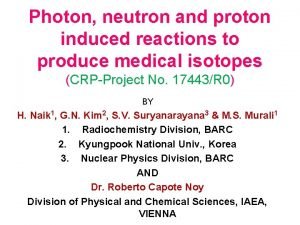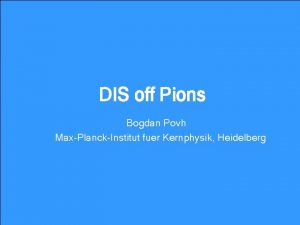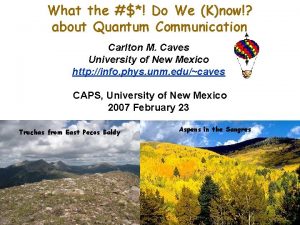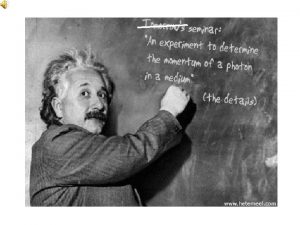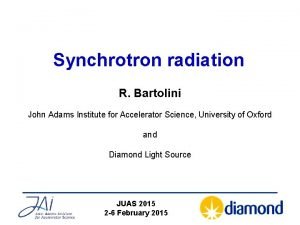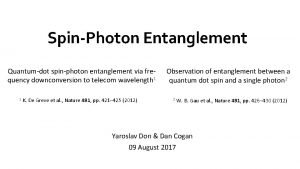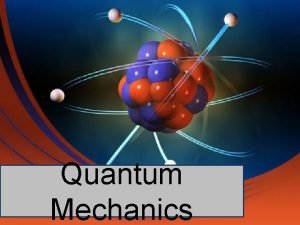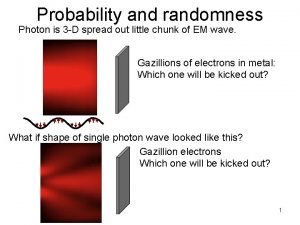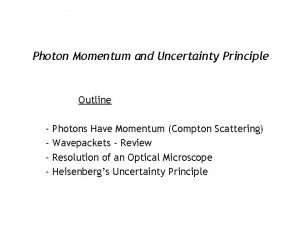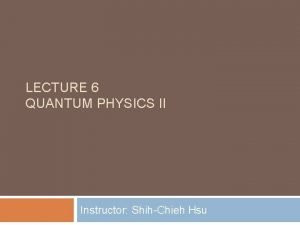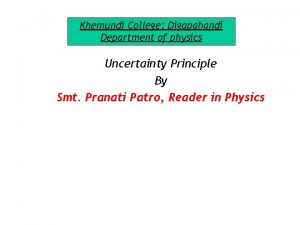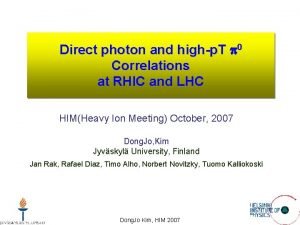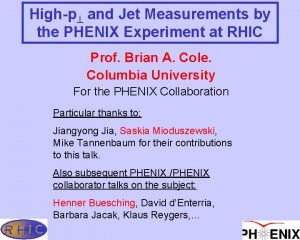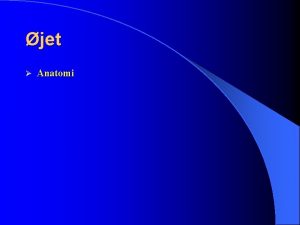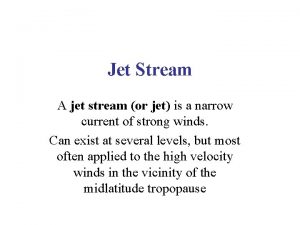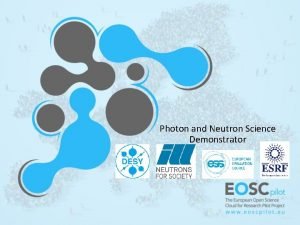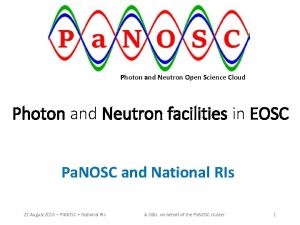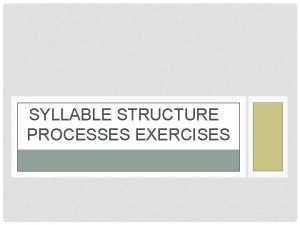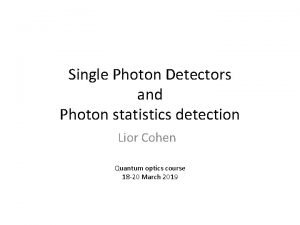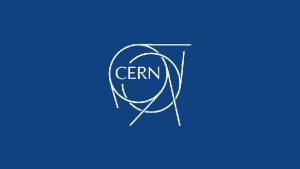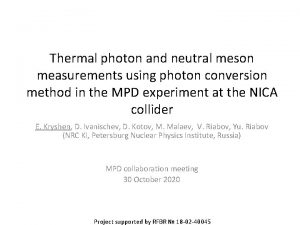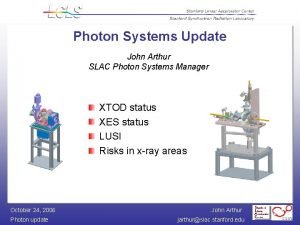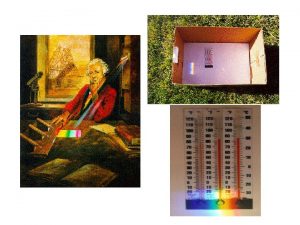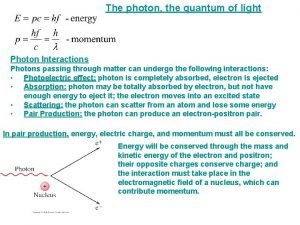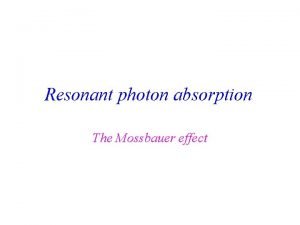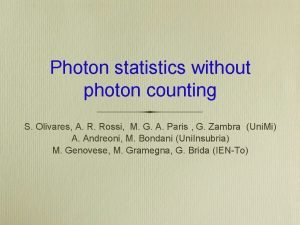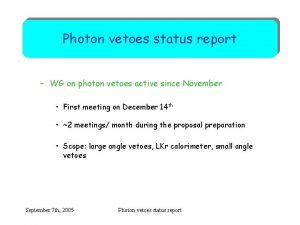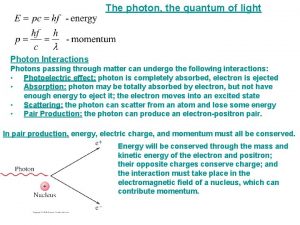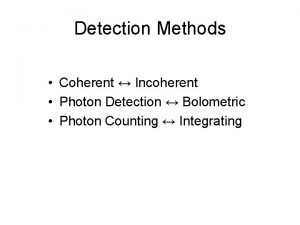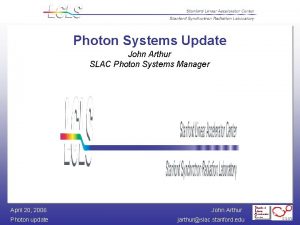Highp T Processes and the Photon Structure Jet






























- Slides: 30

High-p. T Processes and the Photon Structure (Jet) Photoproduction Results from HERA Thomas Schörner-Sadenius Hamburg University on behalf of the H 1 and ZEUS Collaborations Workshop on High-Energy Photon Collisions CERN, 22 April 2008 – Introduction – The resolved photon – Jet cross sections – PDF sensitivity – Prompt photon production – Underlying event and MPI TSS: High-p. T Processes … HERA

HERA, H 1, ZEUS – operation from 1992 -2007 – world’s largest electron microscope (λ~1/Q). – 820/920 Ge. V protons on 27. 5 Ge. V electrons. H 1: – LAr calorimeter with 45000 cells. – e±: σ/E = 12%/√E[Ge. V]+1% ZEUS: – comp. U/scint. , 12 k cells. – hadrons: σ/E = 35%/√E[Ge. V] Silicon tracking; lumi from ep epγ. CERN, 22 April 2008 Ep (Ge. V) HERA (pb-1) ZEUS (pb-1) HERA-I 820 / 920 193 143 HERA-II 920 562 407 LER/MER 460 / 575 16 / 9 13 / 8 TSS: High-p. T Processes … HERA 2

PHYSICS AT HERA The electron as a probe for the proton structure Electroweak, p. QCD e± 27. 5 Ge. V Proton 920 Ge. V k’ k q=k-k‘ √s = 318 Ge. V P e±, ν γ, W, Z p=x. P ● Q 2=-q 2=-(k-k’)2~1/λ 2 (resolution) ● y=qp/kp=1 -E’/E (in p rest frame) ● x=Q 2/(2 pq): 10 -6 < x < 1 Related by Q 2 = sxy; determined from scattered e or from HFS. Quark momentum fraction: x=10 -6 -1 Distinguish: – Neutral and charged current – DIS and photoproduction Resolution: Q 2=0 -105 Ge. V 2 probing 0. 001 -1 fm QCD proton structure described by PDFs fi(x, Q 2) CERN, 22 April 2008 Kinematic variables: DIS @ HERA: 1) super-microscope to study PDFs 2) Sensitivity to EW physics! TSS: High-p. T Processes … HERA 3

JETS: WHY AND WHAT? HERA: rich hadronic final state detailed QCD studies jets, prompt photons CERN, 22 April 2008 TSS: High-p. T Processes … HERA 4

JETS IN PHOTOPRODUCTION Jet technicalities: jet – longitudinally invariant k. T algorithm in inclusive mode – Run on calorimeter cells or “energy flow objects”. – Hard jets selected using cuts on transverse energy ET; , – Detector acceptances -1 < η < 2. 5, with η= –ln tan(θ/2). – (Jet energy scale and jet ET corrections. ) Direct versus resolved photoproduction: jet – Quasi-real photon can fluctuate into hadronic system before undergoing the hard scattering: “resolved” interactions. – Proton and photon momentum fractions xp and xγ: xγ > 0. 8: direct xγ < 0. 8: resolved Spin-1/2 propagator CERN, 22 April 2008 Spin-1 propagator TSS: High-p. T Processes … HERA 5

CONFIRMATION: RESOLVED CONCEPT Observable: CMS scattering angle: cosθ*: Resolved should rise more rapidly due to different nature of propagator: DESY-06 -020 [ ] H 1 data, 66. 6 pb-1, 0. 1 < y < 0. 9 Dijets; ET > 25 Ge. V, -0. 5 < η < 2. 75 CERN, 22 April 2008 Beautiful confirmation of “resolved” concept. similar results from ZEUS (DESY-01 -220) TSS: High-p. T Processes … HERA 6

AMOUNT OF RESOLVED (PHP AND DIS)? Single-differential dijet cross section dσ/d. Q 2: – For photoproduction Q 2 = 0 and DIS (here for Q 2 < 1000 Ge. V 2). – Separately for direct and resolved events (xγ<>0. 75). Even at Q 2 = 500 Ge. V 2 about 24% “resolved” events! NLO QCD ~30% too low. Resolved contribution in DIS not described by NLO QCD (not included in DISASTER++) LO MC models can describe the data. For Q 2 = 0 data in agreement with NLO. DESY-04 -053 CERN, 22 April 2008 [ ZEUS data, 38. 6 pb-1, 0. 2 < y < 0. 55 Dijets; ET > 7. 5/6. 5 Ge. V, -3 < ηγp < 0 TSS: High-p. T Processes … HERA ] 7

JETS IN PHOTOPRODUCTION Cross-sections in direct and resolved: DESY-07 -092 Direct: NLO describes data on the level of about 10%. [ ZEUS data, 81. 8 pb-1, 0. 15 < y < 0. 7 Dijets; ET > 20/15 Ge. V, -1 < η < 3 CERN, 22 April 2008 ] Resolved: large influence of photon PDF (up to 50%) potential to constrain? TSS: High-p. T Processes … HERA 8

PDF SENSITIVITY Theoretical uncertainties … In addition: partly large gluon … for different kinematic regions. contributions from p and/or γ: Proton PDF: Sometimes dominant! Photon PDF: Large effect! CERN, 22 April 2008 Potential to constrain both photon + proton PDFs using high-ET PHP! TSS: High-p. T Processes … HERA 9

IMPROVING THE PROTON PDF Use of double-differental direct dijet cross sections in NLO QCD fits together with DIS jet data … DESY-07 -092 DESY-05 -050 Reduction of proton gluon density uncertainty by up to 40% or so! CERN, 22 April 2008 TSS: High-p. T Processes … HERA 10

JETS IN PHP: RESOLVED … the corresponding resolved data: DESY-07 -092 – Data not described over all phase-space. – Systematic differences between GRV and AFG photon PDFs (15%). CERN, 22 April 2008 TSS: High-p. T Processes … HERA 11

JETS IN PHP: xγ, xp Interest in photon (and proton) structure measure xγ (and xp)! Boson-gluon fusion (70%) [ ] H 1 data, 66. 6 pb-1, 0. 1 < y < 0. 9 Dijets; ET > 25 Ge. V, -0. 5 < η < 2. 75 DESY-06 -020 QCD-Compton (15%) – NLO describes data over basically all phase space within errors (jet scale!). – PYTHIA with GRV-LO, NLO with GRV-HO as photon PDF. CERN, 22 April 2008 TSS: High-p. T Processes … HERA 12

JETS IN PHP: PSEUDORAPIDITIES etc. Jet pseudorapidities: Sensitivity to momentum distributions of incoming hadrons. (double-differential) measurements in η, ET (or xp). DESY-07 -092 DESY-06 -020 NLO describes data well (small discrepancies in direct with both jets forward). CERN, 22 April 2008 – Potential to constrain p and γ PDF. – Often CJK γ PDF best (in shape). – Differences between γ PDFs up to 50% constrain photon structure! TSS: High-p. T Processes … HERA 13

PROMPT PHOTONS: DIS Photon from lepton (LL), quark (QQ) or interference (LQ). Alternative access to QCD issues: Different systematics. Smaller hadronisation corrections. In addition importance for new-physics searches. Inclusive isolated photon cross section Isolated photon + jet cross section ] CERN, 22 April 2008 DESY-07 -147 [ H 1, 227 pb-1, 4 < Q 2 < 150 Ge. V 2 3 < ETγ < 10 Ge. V, y > 0. 05 Without jet requirement (LO) theory factor 2 below data, shapes agree. With jet requirement (NLO) theory better. TSS: High-p. T Processes … HERA 14

PROMPT PHOTONS: PHP … after the problems in DIS, how about PHP? Comparison of data direct+resolved contribution. access to p and γ PDFs. – to NLO (DGLAP) calculation (Fontannaz et al. ) – to k. T factorisation approach (Zotov et al. ) DESY-07 -147 [ H 1, 340 pb-1, 2004 -2007 data 5 < ETγ < 15 Ge. V, 0. 1 < y < 0. 7 CERN, 22 April 2008 ] Both calculations undershoot data. Slightly improved situation for photon+jet requirement (like in DIS). TSS: High-p. T Processes … HERA 15

THE UNDERLYING EVENT Resolved PHP: hadron-like phenomenon of underlying event! – (soft) beam remnant interactions – additional (semi)hard constituent scatterings (multi-parton interactions, MPI) – initial and final state radiation etc. Quantify: “Activity in transverse regions” CDF experience: – MPI models can be tuned to CDF data! – But extrapolation to LHC not meaningful! Important + theoretically challenging! CERN, 22 April 2008 Number of charged particles Regions away from hard scattering products (jets) should be most sensitive to UE effects. TSS: High-p. T Processes … HERA leading jet p. T 16

UE/MPI NECESSITY ¶ HERA measurements demonstrate necessity of UE/MPI – Photoproduction dijets at HERA, - H 1: ZP C 70 (1996) 17 - ZEUS: EPJ C 1 (1998) 109 ZEUS 1994 (2. 7 pb-1) HERWIG+JIMMY HERWIG δη Jet profiles: energy flow relative to jet axis in different η regions CERN, 22 April 2008 TSS: High-p. T Processes … HERA 17

UE MODEL IMPLEMENTATIONS ¶ PYTHIA + MPI – Various models (old / intermediate / new): differ wrt color flow, remnant treatment, showering initiators, shower mode, interleaving of ISR and MPI, … – simple overlap of hadrons or impact-parameter dependence – Average number of interactions per event derived from regularised 2 2 cross-section and total cross-section; secondary interactions Sudakovsuppressed. ¶ HERWIG + JIMMY – Based on eikonal model assuming matter distributions in colliding particles and an overlap function A(b). – Assign 2 2 cross-section to all events, choose number of interactions according toprecalcuted probability distribution. ¶ More models: – Sherpa: similar assumptions as in PYTHIA, module AMISIC++ for MPIs. – Phojet: Not part of general purpose generator, limited use for HEP. CERN, 22 April 2008 TSS: High-p. T Processes … HERA 18

H 1 ANALYSIS: MINIJETS IN DIS ¶ Measure for UE <NMini. Jet> H 1 -prelim-07 -032 – average number of low-p. T “mini” jets in different azimuthal regions as function of p. T, lead. – Inclusive (dijet) sample in regions of Q 2 and ηlab (xγ). – Data compared to PYTHIA, ARIADNE, RAPGAP, … [ ] H 1 data, 57. 4 pb-1, 5<Q 2<100 Ge. V 2. Jets: p. T > 5 Ge. V, minijets: p. T > 3 Ge. V. Dijets Azimuthal separation: > 140 o. CERN, 22 April 2008 Jet regions: PYTHIA (no MPI) okay! Transverse regions: MPI needed! TSS: High-p. T Processes … HERA 19

H 1: DIJET SAMPLE ¶ Jet regions: H 1 -prelim-07 -032 – all models with and without UE/MPI describe data. – data generally above the models. – Some UE influence; MPI again needed to describe data. <NMini. Jet> ¶ Transverse regions Influence of MPI / necessity of its modelling demonstrated. Underlying effects not very well understood. Pin down mechanism with data like these? Energy evolution? CERN, 22 April 2008 TSS: High-p. T Processes … HERA 20

ZEUS: MULTIJETS IN γ*p ¶ Measure for UE: – 3 - and 4 -jet cross-sections. – Jets 3, 4 generated by hard QCD radiation? MPI? ¶ Models for comparison: – HERWIG 6. 505 + JIMMY 4. 0 – PYTHIA 6. 206 + “simple” MPI model – Also: NLO calculation (Klasen et al. ) for 3 jet case (effectively LO!) DESY-07 -102 [ ] ZEUS data, 121 pb-1, 0. 2 < y < 0. 85. Jets: ET > 6 Ge. V, |η| < 2. 4. High/low-mass region: Mnj <> 50 Ge. V CERN, 22 April 2008 Need MPI/UE simulations to correctly describe the data: HERWIG and PYTHIA without UE / MPI fail to describe data at low Mnj. TSS: High-p. T Processes … HERA 21

ZEUS 3 - AND 4 -JETS: dσ/dxγ – Models without MPI suggest decreasing cross-sections with decreasing xγ. – But for low masses large discrepancy with INCREASING data mechanism beyond direct+resolved as modelled in MC necessary. – Even “direct” region (xγ > 0. 75) dominated by resolved events (↔dijets!). – Especially HERWIG+JIMMY describes data well. – Note large systematic uncertainties: Model dependence CERN, 22 April 2008 TSS: High-p. T Processes … HERA 22

ZEUS MULTIJETS ¶ dσ/dη versus LO models: ¶ dσ/d. M 3 j versus “NLO”: – High-mass data described by all models. – Large MPI corrections (from models) at – Best description of low-M data: HERWIG. low masses! Large theo. uncertainties. – MPI improve description at high η. Similar message for ET spectra. CERN, 22 April 2008 TSS: High-p. T Processes … HERA 23

SUMMARY ¶ Jets in photoproduction: – Possibility of many QCD tests (coupling, factorisation, perturbation theory, …) – Sensitivity to both photon and proton PDFs! p. PDF already improved using jet data (ZEUS-JET proton PDF). – Direct part of data typically well described by NLO QCD calculations / LO models. – Large (50%) differences between different γ PDFs potential to constrain? ¶ Prompt photon production: – Alternative access to QCD issues; different systematics (hadronisation!) – DIS: Models and (LO) calculations tend to undershoot data (factor 2). – Photoproduction: Similar as in DIS. Photon+jet requirement helps a bit. ¶ Multi-parton interactions: – Resolved photoproduction: Multiple parton Interactions possible! – HERA data clearly indicate necessity for MPI contributions to models. – HERA (low-energy) points helpful in identifying the underlying mechanism? ¶ Many HERA-II results to come! – So far most results with limited HERA-I statistics! – Many measurements limited by renorm. scale uncertainty! Need theoretical input! CERN, 22 April 2008 TSS: High-p. T Processes … HERA 24

JETS IN PHP: “OPTIMIZED” REGIONS Regions of phase-space with particular sensitivity to PDFs (gluon): Isolate regions with large gluon contributions. direct / resolved to isolated influence of photon / proton PDFs. DESY-07 -092 Potential of these and similar data to further constrain the photon! CERN, 22 April 2008 TSS: High-p. T Processes … HERA 25

RESOLVED VERSUS DIRECT Ratio R=σ(resolved)/σ(direct) as fct of Q 2 in regions of mean ET: – Better understanding of resolved component at Q 2 > 1 Ge. V 2? – Data compared to HERWIG LO MC with two different photon PDFs, and to NLO. DESY-04 -053 Sa. S 2 d with γ PDF suppression reproduces the data! CERN, 22 April 2008 DESY-04 -053 PHP Description depends on photon PDF used! Some Q 2 suppression. TSS: High-p. T Processes … HERA 26

CONFIRMATION: RESOLVED CONCEPT Similar result from ZEUS: DESY-01 -220 [ CERN, 22 April 2008 ZEUS data, 38. 6 pb-1, 0. 2 < y < 0. 85 Dijets; ET > 14/11 Ge. V, -1 < η < 2. 4 TSS: High-p. T Processes … HERA ] 27

JETS IN PHOTOPRODUCTION DESY-07 -092 CERN, 22 April 2008 TSS: High-p. T Processes … HERA 28

JETS IN PHOTOPRODUCTION Jet pseudorapidities: Sensitivity to momentum distributions of incoming hadrons. double-differential measurements in η, ET (or xp). DESY-06 -020 – NLO describes data well (small discrepancies in direct with both jets forward). – Detailed ZEUS study: Large potential of data to constrain p and γ PDF. CERN, 22 April 2008 TSS: High-p. T Processes … HERA 29

JETS IN PHOTOPRODUCTION Similar findings at ZEUS: Large influence of photon PDF in use; often CJK describes best the trend of the data (but normalisation). Differences between different parametrisations up to 50%! DESY-07 -092 CERN, 22 April 2008 TSS: High-p. T Processes … HERA 30
 Yelvington jet aviation aircraft fuel
Yelvington jet aviation aircraft fuel Photon structure
Photon structure Photon structure
Photon structure Concurrent in os
Concurrent in os Motion-to-photon latency
Motion-to-photon latency Wavelength unit
Wavelength unit Photon
Photon Photon is our business
Photon is our business What is a photon made of
What is a photon made of Electron vs photon
Electron vs photon Photon assay technology
Photon assay technology Desy photon science
Desy photon science Stochastic progressive photon mapping
Stochastic progressive photon mapping Lepton-photon
Lepton-photon Photon cross section
Photon cross section Single photon
Single photon Single photon
Single photon Photon uncertainty principle
Photon uncertainty principle Photon neutron
Photon neutron Photon neutron
Photon neutron Ortec 257p
Ortec 257p Photon neutron
Photon neutron Photon polarization
Photon polarization Momentum of photon is
Momentum of photon is Photon density formula
Photon density formula Photon polarization
Photon polarization A photon checks into a hotel
A photon checks into a hotel Photon chunk
Photon chunk Momentum of photon
Momentum of photon Jj thomson
Jj thomson Momentum of photon formula
Momentum of photon formula

